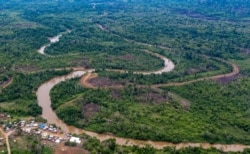The number of child migrants passing through the perilous Darien Gap between Colombia and Panama has risen dramatically, the U.N. child welfare agency said Monday.
Underage migrants made up only about 2% of those using the jungle corridor in 2017. In 2020, children made up 25% of the migrants making the hard trek on foot, UNICEF's report said.
The Darien Gap is a 60-mile (97-kilometer) stretch of roadless jungle that provides the only land route north out of South America. There is little food or shelter on the weeklong trek and bandits and wild animals prey on migrants.
Most migrants making the hike are from Haiti or Cuba, with smaller numbers from African nations, such as Cameroon and Congo, and South Asian countries, such as India, Bangladesh and Sri Lanka.
"I have seen women coming out of the jungle with babies in their arms after walking for more than seven days without water, food or any type of protection," said Jean Gough, the UNICEF regional director who made a two-day trip to the zone.
"These families go beyond their limits and put their lives at risk, often without realizing the risks they are taking," Gough said. The risks for children are particularly serious.
"The migrants who get trapped there (in the jungle) are exposed to many threats, including death," the U.N. report said. "In this context, women, especially pregnant women, girls, children and adolescents, are the most vulnerable."
While 109 children made the journey in 2017, that swelled to 3,956 in 2019. The coronavirus pandemic and travel restriction reduced both adult and child numbers in 2020, with the latter falling to 1,653.
Over the last four years, a total of at least 46,500 migrants had made the trek, and in total for those years they included 6,240 minors.
"The socioeconomic repercussion of the COVID-19 pandemic, together with violence, racism, unemployment and extreme climate events will probably increase poverty and lead more families to migrate north in the coming months," the report added.
The U.S. government has been facing an increase in the number of unaccompanied minors and families with children arriving at its southern border in recent months. Last week there were about 18,000 unaccompanied children in government custody.









